College Avenue Contact Tank (2020)
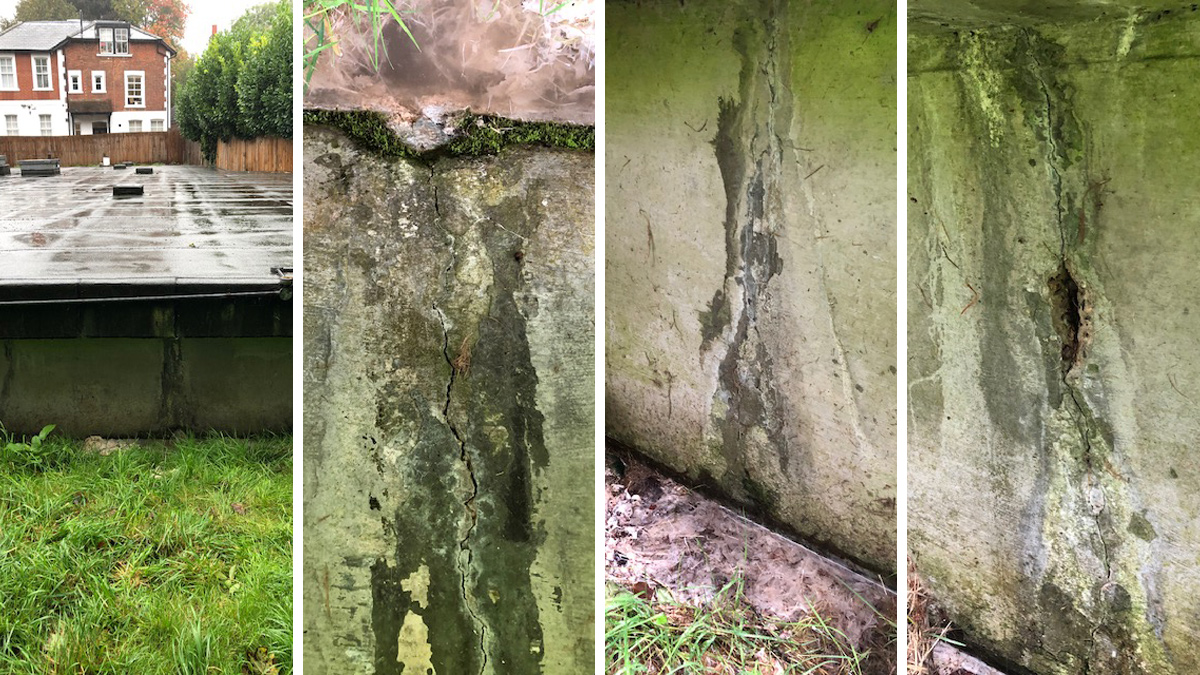
Photographs of leaking cracks observed in November 2019 - Courtesy of South East Water
South East Water’s College Avenue Water Treatment Works in Berkshire supports the Maidenhead water supply infrastructure. It extracts raw water from three boreholes and three chalk wells, which is then dosed with sodium tripolyphosphate (STPP), aerated, passed through granular activated carbon (GAC) absorbers, and finally injected with sodium hypochlorite to super-chlorinate it before entering the chlorine contact tank (CT). Treated water is subsequently transferred by four high lift pumps (HLPs) to the Maidenhead distribution network with a constant output of 18.1 Ml/d, serving 12 interconnected district metered areas (DMA). This strategically important production site must run constantly and without any extended outages to maintain supply to over twenty thousand properties.
Background
In November 2019 external leaks from the western concrete wall of the contact tank were observed. The condition of the structure caught the immediate attention of site production managers. While a long-term project to replace the tank with a new permanent UV treatment plant had already been identified by South East Water, a short-term repair solution was urgently needed.
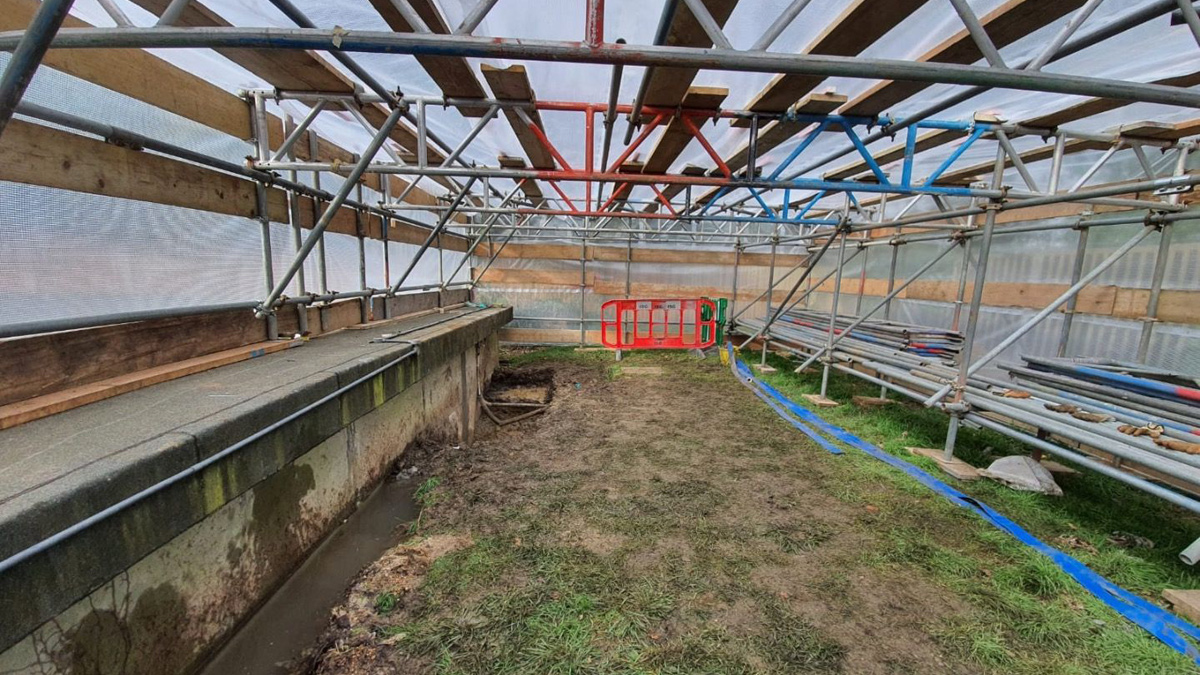
College Avenue contact tank construction site – Courtesy of Stonbury
Most typical repair practices on concrete water retaining structures involve draining, cleaning and thoroughly drying surfaces to allow repair works and materials to be installed in accordance to their required technical specifications. However, in this project, it was determined that normal repair methods could not be adopted due to structural and operational constraints which prevented the tank to be dewatered and entered. Engineers were therefore challenged to find new alternative solutions in order to stop these leaks, re-establish weathertightness and barrier protection from contaminants while the structure was in use.
Project team
The project design was delivered through the collaboration of the co-located South East Water and Jacobs engineering team. The multidisciplinary team, experts in hydraulic design, reservoirs maintenance and civil engineering, devised the overall solution. External construction partners were appointed for the repair work. Structural condition assessments were undertaken by Mason Clark. Stonbury, the main reservoir framework contractor for the Reservoir Maintenance Programme, carried out the temporary works and the repair of the structure. This shared responsibility ensured the project could deliver best value to South East Water and its customers.
Design – Project criteria & constraints
In order to develop the most appropriate repair methodology, it was important to review the maintenance history of the reservoir, including previous structural inspection reports. This helped to establish the project design criteria and constraints which are summarised as follow:
- The 520m3 below ground reinforced concrete structure built in 1958, approximately 10m long, 20m wide and 2.2m deep, had in recent years undergone major structural interventions including the erection of an internal support system to the roof beams which had displayed cracks with some concrete spalling and the exposure of reinforcement bars. This provided engineers with an initial overall insight into the poor condition of the structure.
- Operational constraints, later confirmed by detailed hydraulic modelling, restricted internal access for repair activities to a maximum period of 24 hours. This was considered insufficient to enable any internal repair to be successfully completed.
- Briefly removing the contact tank from service for a visual assessment could have generated water quality issues, as the result of the draining operation which could have drawn contaminants through the cracks, preventing an immediate return to service.
For the above reasons, and in order to avoid any cyclic loading imposed onto the weak structure if it was drained, it was decided that repairs would have to be carried out from the outside with the reservoir full and without constraining normal operational activities.
Optioneering studies
Optioneering studies embedded within design and construction processes were conducted as they had the potential to enhance the quality of the solution to be adopted. This process involved option identification, assessment and definition and included an evaluation of the risks in uncertain future scenarios. Designers developed three main options:
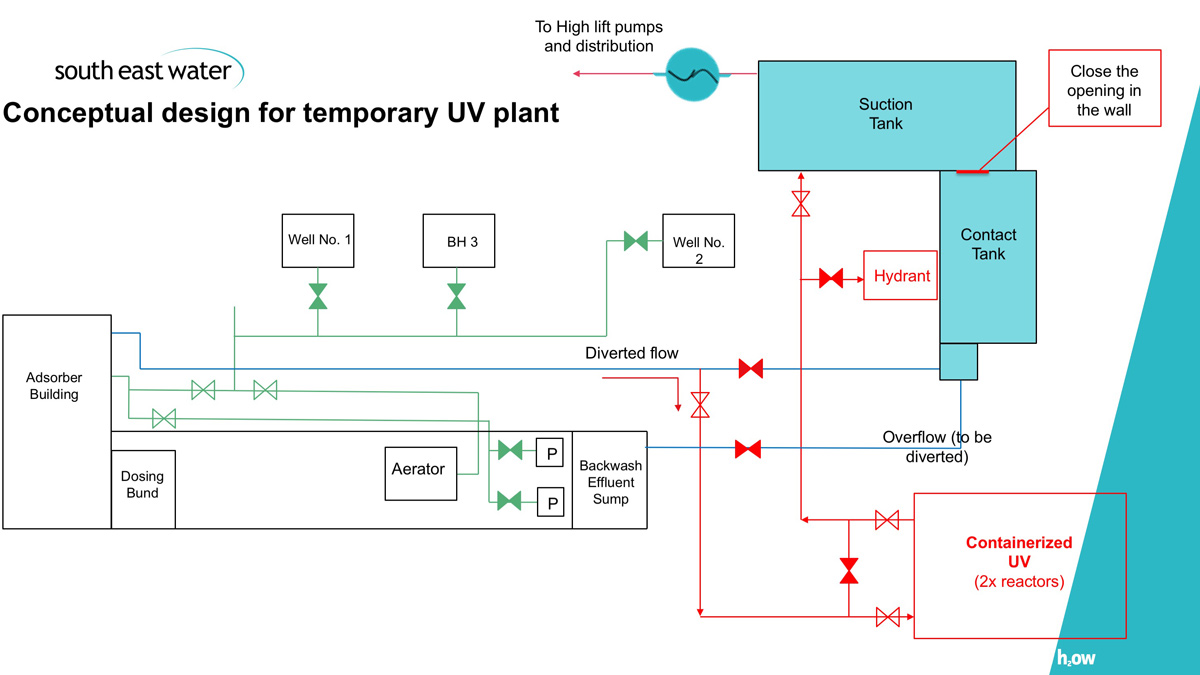
Conceptual design for a temporary UV plant- Courtesy of South East Water
Option 1: Temporary containerised UV plant: A temporary containerised UV plant solution was considered, as this treatment process would make the existing contact tank redundant while repairs could be undertaken. The study concluded that this option was not practicable nor cost effective due to the little space available for a hired containerised UV plant and the extensive electro-mechanical and civil enabling works that this solution would have required.
Option 2: External Wall Overbanding: This repair method, consisting of sealing cracks or joints of concrete surfaces with bands, was discounted due to the potential of the waterproofing tape to become detached by the internal hydrostatic pressure building up through the cracks behind the banding. Steel plates were considered to overcome this issue, but it was deemed too risky due to hazards associated with the drilling and fixing of the plates to the wall, potentially generating additional larger water leaks and even causing serious damage to the structure.
Option 3: Application of Xypex (preferred solution): The preferred option was to complete the repair using Xypex products. These are specially formulated portland cement, finely graded sand and active proprietary chemical compound, that by means of diffusion fill the cracks with an impermeable crystalline structure which renders the concrete structure waterproof. The advantage of Xypex over other methods of repair was its ability to stop leaks in structures that are weeping, or even actively flowing, through concrete structures while the repair is undertaken live i.e. in this case with the reservoir full and operational, and all in compliance with the strictest water quality safety regulations as enforced by the DWI. Xypex was an ideal choice in these specific circumstances, as unlike other products, it did not require heating, dehumidification, wet vacuumed or drag dried surfaces. On the contrary, the manufacturer’s instruction for use (IFU) specified the use of water to be regularly applied during and post application to help the formation of the crystallisation process, which was conveniently available from the leaking cracks.
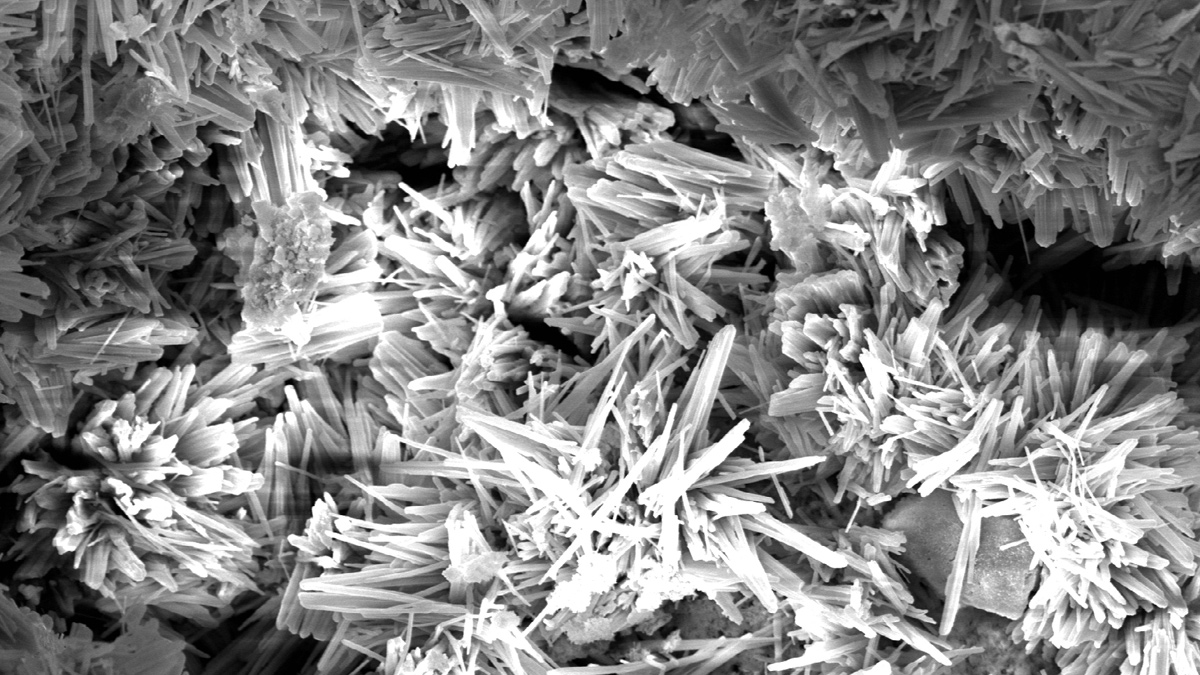
Concrete waterproofing by crystallisation. Crystalline growth continues to develop and mature as the diffusion front progresses deeper into the concrete – Courtesy of Xypex
Testing and stakeholder engagement
A rigorous technical evaluation in conjunction with extensive stakeholder consultation was a key factor in successfully seeking approval from the business to use this innovative product, which had never been tested before within South East Water.
The Engineering design team engaged in a range of discussions, site visits and workshops with various South East Water departments, South East Water’s supply chain and framework contractors. The discussions and a practical demonstration on a purposely made concrete tank at the Xypex training facilities in Banbury, Oxfordshire, ultimately led to the acceptance and use of the product. The event brought together an advisory group of over 15 key stakeholders including South East Water’s reservoirs, water quality and operations managers, consultants from Jacobs, contractors from Stonbury and the supplier, SMR Projects Ltd – UK Xypex Distributor.
Structural assessment
Careful structural testing on the concrete wall in conjunction with a temporary works design was undertaken to establish if the original design and the condition of the wall could cope with the removal of the surrounding backfill to the tank. This was an important consideration as the repairs to the wall were to be done on the reservoir at full to top water level. In order to limit any excessive structural loading on the wall during the repair works, Mason Clark recommended that the cracks being repaired were only exposed locally by excavating ground around a crack to a maximum width of about 2m.
An independent review of the structural reports had additionally been carried out by a structural concrete specialist team from Jacobs who formed the same view. Engineers’ comments and observations were incorporated into the contractor’s method statement and this mitigated project risks, making it safe for the specialised repair crew.
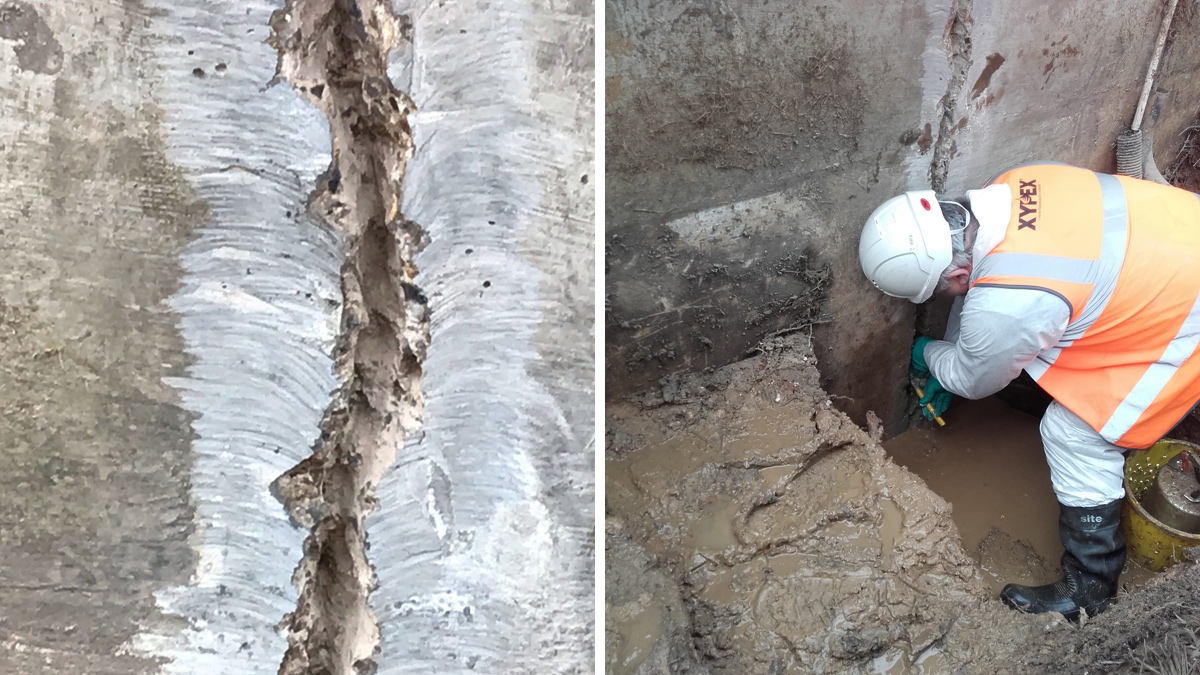
(left) Crack preparation with jack hammer in “U” shape slot and (right) placing a bleeder hose into the cavity – Courtesy of South East Water
College Avenue Contact Tank Repair: Supply chain – key participants
- Civil engineering design: Jacobs/South East Water (combined team)
- Civil engineering contractor: Stonbury
- Structural engineering and temporary works: Mason Clark Associates
- Materials supplier: SMR Projects Ltd (UK Xypex Distributor)
Construction method
The repair works involved around twenty specific predefined steps including materials’ mixing, crack cleaning and preparation with jack hammer in a U shape form, placing of a bleeder hose into the cavity, stemming the water flow with Xypex Patch’n Plug and then repair using a dry packing method, and slurry coat applications of Xypex Concentrate finally followed by the installation of strain gauges for future structural monitoring.
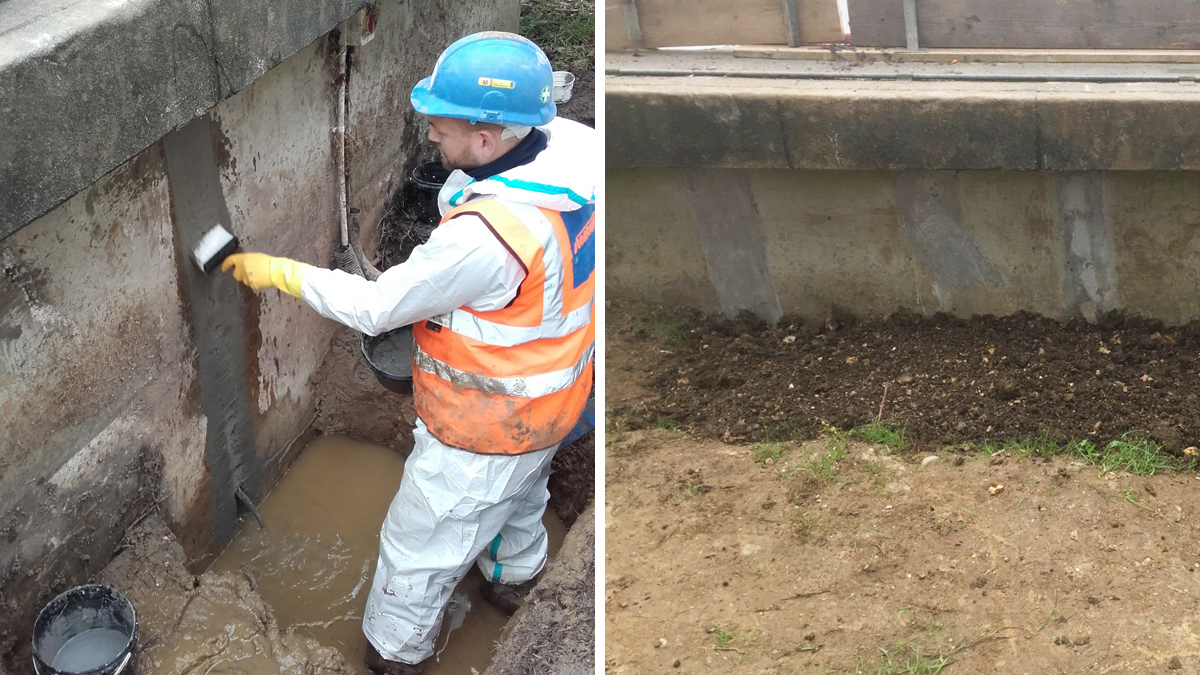
(left) Slurry coat applications of Xypex Concentrate – Courtesy of South East Water and (right) view of cracks repaired – Courtesy of Stonbury
Conclusions
Repairs works were successfully completed in March 2020, despite the challenges of working in tight spaces and while keeping social distancing during the COVID-19 restrictions. The tank is being regularly monitored and has not displayed signs of leaks or dampness or movement. The project took around four months for materials research and confirmation, design and planning followed by two months of construction. By designing, testing and implementing this innovative solution engineers were able to repair this critical structure safely, at minimum costs and most of all without any plant outages providing maximum benefits to South East Water’s customers.




